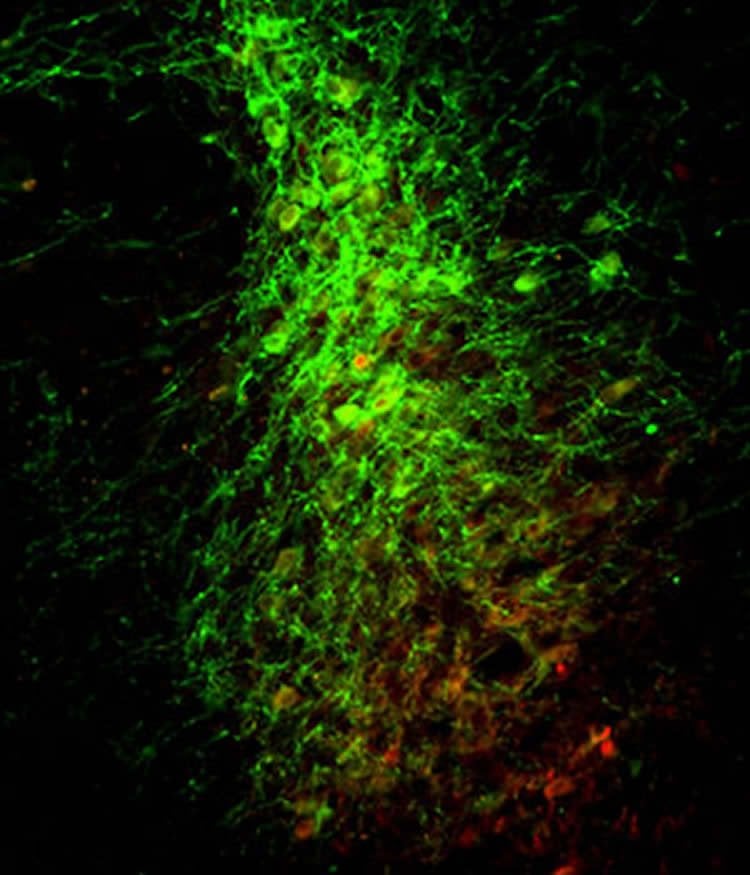Calming a neural circuit in the brain can alleviate stress in mice, according to new research that could lay the foundation for understanding stress and anxiety in people.
Using cutting-edge techniques, the researchers at Washington University School of Medicine in St. Louis also showed they could shine a light into the brain to activate the stress response in mice that had not been exposed to stressful situations.
The study is published online July 23 in the journal Neuron.
“We now have a much better idea of the neural circuit involved in producing anxiety following stress,” said first author Jordan G. McCall, PhD, a former graduate student in the laboratory of principal investigator Michael R. Bruchas, PhD, associate professor of anesthesiology and neurobiology. “You can imagine that this same response also may be important to longer-term stress-related problems such as post-traumatic stress disorder (PTSD) or anxiety disorder.”
The work may lead to the development of new treatments for such disorders, as well as for depression and alcohol and drug abuse.
Neuroscientists already knew that a small structure in the brain called the locus coeruleus (LC) plays a key role in stress and anxiety. Neurons in that region secrete the hormone norepinephrine, which surges when a person is under stress. But using techniques called optogenetics and chemogenetics, the researchers showed they could selectively control the firing of LC neurons, lower norepinephrine levels and prevent the anxiety that normally follows stressful events.
In these techniques, researchers genetically engineer mice with brain cells that have special receptors. Those receptors can be activated by light (optogenetics) or synthetic chemicals (chemogenetics). Those light or chemical signals either trigger or block neuronal activity, giving researchers a way to control the brain circuits in an animal and, thus, the behavior.
As part of the research, the scientists observed mice moving through mazes and roaming freely in an open box.

“Mice usually move toward the wall and try to stay out of the open area, just like a mouse in your house,” Bruchas explained. “Anxious mice rarely venture into the center of the box, whereas mice that feel less anxious roam into the middle more often.”
Mice that experienced stressful events were more likely to stay near the edges of the box. But when mice were treated with stress-lowering drugs — either beta blockers or alpha 1 blockers, which are used to treat high blood pressure and stress in people — the animals were more likely to venture into the middle of the box, even if they had experienced stressful events.
The researchers also found that activating LC neurons with light made mice in the mazes behave as if they were stressed, even when they had not been exposed to a stressful event.
“With this study, we now understand how a bunch of puzzle pieces fit together in a network that we’ve demonstrated is critical to stress-induced anxiety,” Bruchas said.
Funding: Funding for this research comes from the National Institute on Drug Abuse (NIDA) and the National Institute of Mental Health (NIMH) of the National Institutes of Health (NIH), grant numbers R21 DA035144, R01 DA035821, F31 MH101956 and K99 DA038725; the McDonnell Center for Systems Neuroscience; and the Washington University Division of Biology and Biological Sciences.
Source: Jim Dryden – WUSTL
Image Credit: The image is credited to Bruchas Lab
Original Research: Abstract for “CRH Engagement of the Locus Coeruleus Noradrenergic System Mediates Stress-Induced Anxiety” by Jordan G. McCall, Ream Al-Hasani, Edward R. Siuda, Daniel Y. Hong, Aaron J. Norris, Christopher P. Ford, and Michael R. Bruchas in Neuron. Published online July 23 2015 doi:10.1016/j.neuron.2015.07.002
Abstract
CRH Engagement of the Locus Coeruleus Noradrenergic System Mediates Stress-Induced Anxiety
Highlights
•Inhibition of LC-NE neurons during stress prevents subsequent anxiety-like behavior
•Increased tonic LC-NE neuronal activity promotes anxiety-like and aversive behavior
•CRH+ CeA-LC projections increase LC-NE activity and promote anxiogenic responses
•CRH+ CeA-LC-induced anxiety-like behavior is mediated by CRHR1 receptors
Summary
The locus coeruleus noradrenergic (LC-NE) system is one of the first systems engaged following a stressful event. While numerous groups have demonstrated that LC-NE neurons are activated by many different stressors, the underlying neural circuitry and the role of this activity in generating stress-induced anxiety has not been elucidated. Using a combination of in vivo chemogenetics, optogenetics, and retrograde tracing, we determine that increased tonic activity of the LC-NE system is necessary and sufficient for stress-induced anxiety and aversion. Selective inhibition of LC-NE neurons during stress prevents subsequent anxiety-like behavior. Exogenously increasing tonic, but not phasic, activity of LC-NE neurons is alone sufficient for anxiety-like and aversive behavior. Furthermore, endogenous corticotropin-releasing hormone+ (CRH+) LC inputs from the amygdala increase tonic LC activity, inducing anxiety-like behaviors. These studies position the LC-NE system as a critical mediator of acute stress-induced anxiety and offer a potential intervention for preventing stress-related affective disorders.
“CRH Engagement of the Locus Coeruleus Noradrenergic System Mediates Stress-Induced Anxiety” by Jordan G. McCall, Ream Al-Hasani, Edward R. Siuda, Daniel Y. Hong, Aaron J. Norris, Christopher P. Ford, and Michael R. Bruchas in Neuron. Published online July 23 2015 doi:10.1016/j.neuron.2015.07.002






